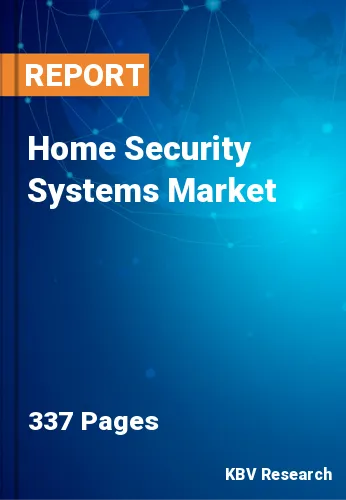The Global Home Security Systems Market size is expected to reach $96.5 billion by 2028, rising at a market growth of 9.1% CAGR during the forecast period.
When a secured zone is broken, a home security system consists of a mix of software and hardware technologies that are designed to detect an intrusion or unauthorized entrance. It can function even in the event of a power loss and warns of potential environmental hazards like carbon monoxide poisoning, fire, flooding, and so on. Nowadays, home security systems are microprocessor-based and perform a wide range of duties while providing a user-friendly interface.
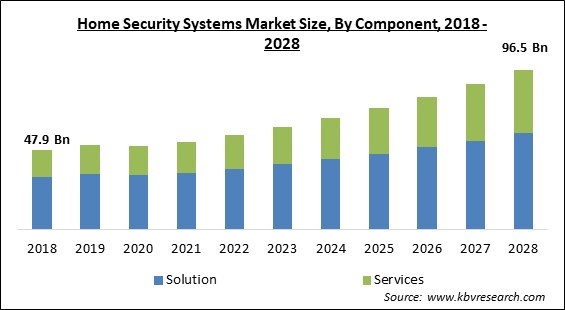
Smart security cameras connect to Wi-Fi, allowing user to remotely live stream images of the system and receive alerts when the cameras detect movement, persons, or parcels. Many cameras come with infrared or color night vision, cloud or local storage, and two-way audio, allowing the user to communicate with whoever is on camera. Smart platform integrations, such as Amazon Alexa or Google Assistant, are also available on some cameras.
Motion sensors should be installed in a main entryway or hallway on the ground level of a property to detect motion and notify the user when the security system is activated. Entry sensors, also known as contact sensors, are made up of two parts: one which goes on the door or window and the other on the frame. The sensor will notify the user if it believes an entrance point has been opened. On the bottom floor, it is recommended installing entry sensors on windows or doors.
The pandemic COVID-19 had a significant impact on the home security systems market. Manufacturing delays and the temporary suspension of non-essential transportation caused a substantial drop in comprehensive sales in 2020. COVID-19 has had a severe negative impact on major markets such as the United States and China, with supply chain disruption in China resulting in a drop in demand for home security systems. Demand in China has been impacted by a drop in the number of new development projects and the closure of manufacturing operations.
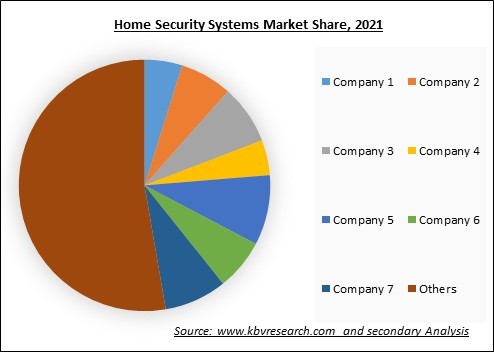
The leading players in the market are competing with diverse innovative offerings to remain competitive in the market. The below illustration shows the percentage of revenue shared by some of the leading companies in the market. The leading players of the market are adopting various strategies in order to cater demand coming from the different industries. The key developmental strategies in the market are Acquisitions.
IoT-based security systems improve user safety by sending quick notifications. Smart sensing identifies and informs the user of changes in motion, heat, and sound. With the availability of a vast number of high-quality data, IoT makes devices smarter. For example, the utilization of high-definition cameras, infrared vision, and night vision surveillance systems ensure that the specifics of any incident are available 24 hours a day, seven days a week.
AI has made it possible to connect automated health assessment and medical alert systems with a complete home security system. In addition to the rising usage of home security systems for video surveillance, hazard detection, and access control applications, residents' cognitive and physical health monitoring is gaining traction, particularly home-based monitoring of the elderly. The AI-based cognitive analysis collects and analyses data on the occupant's activities and health status.
The cost of the hardware, software and services required to establish a security system has a considerable impact on the adoption of home security solutions. This is owing to the pricey hardware and consultancy fees, and the upfront installation cost of a professionally installed system is also high. The cost of ownership is also considered because the system necessitates regular maintenance, subscription fees, and replacement costs in the event of damage. Subscription costs levied by third-party monitoring companies often range to a certain figure. Furthermore, software with extensive analytics features is costly and adds to the system's overall cost.
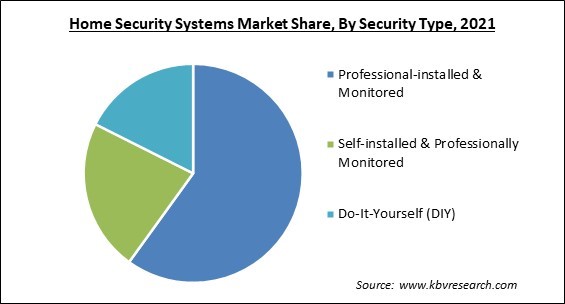
By components, the home security systems market is bifurcated into Solution and Services. By Solution Type, the home security systems market is classified into Fire Protection systems, Video Surveillance Systems, Access Control systems, Entrance Control systems, and Intruder Alarm systems.
By Solution Type, the home security systems market is classified into Fire Protection systems, Video Surveillance Systems, Access Control systems, Entrance Control systems, and Intruder Alarm systems. The Video Surveillance System segment witnessed the maximum revenue share in the home security systems market in 2021. The method of monitoring the activity and conduct of individuals, groups of humans, and/or machines for the purposes of managing, guiding, influencing, or protecting people is known as video surveillance. The Video Surveillance Systems industry is growing due to the strong demand for networked cameras.
By Home Type, the home security systems market is divided into Independent Homes and Condominiums/ Apartments. The independent homes segment witnessed a promising revenue share in the home security systems market in 2021. It is due to independent homes requiring a higher level of security as there is a lack of general security services provided by any security agencies. Including home security systems in an independent house offers more ample amount of security than a security agency.
By Security, the home security systems market is fragmented into Professional-installed and monitored, Self-installed and professionally monitored, and Do-It-Yourself (DIY). The professional-installed and monitored segment acquired the highest revenue share in the home security systems market in 2021. If an individual has a professionally monitored system, a call center monitors the setup 24 hours a day, seven days a week, and receives a notification when something activates the alarm. The service includes monitoring of the area, instantly when the siren is blown in order to ensure everything is fine in respect to home security.
| Report Attribute | Details |
|---|---|
| Market size value in 2021 | USD 53.1 Billion |
| Market size forecast in 2028 | USD 96.5 Billion |
| Base Year | 2021 |
| Historical Period | 2018 to 2020 |
| Forecast Period | 2022 to 2028 |
| Revenue Growth Rate | CAGR of 9.1% from 2022 to 2028 |
| Number of Pages | 349 |
| Number of Tables | 553 |
| Report coverage | Market Trends, Revenue Estimation and Forecast, Market Share Analysis, Segmentation Analysis, Regional and Country Breakdown, Competitive Landscape, Companies Strategic Developments, Company Profiling |
| Segments covered | Component, Home Type, Security Type, Region |
| Country scope | US, Canada, Mexico, Germany, UK, France, Russia, Spain, Italy, China, Japan, India, South Korea, Singapore, Malaysia, Brazil, Argentina, UAE, Saudi Arabia, South Africa, Nigeria |
| Growth Drivers |
|
| Restraints |
|
By Region, the home security system market is analysed in North America, Europe, Asia Pacific, and LAMEA. North America emerged as the leading region in the home security systems market with the largest revenue share in 2021. The region is leading the way in terms of introducing access control systems to increase security and safety. Companies operating in the United States, Canada, and Mexico are expanding the competence in access control systems in order to provide novel technology and services in this segment and obtain a competitive edge over competitors from other nations.
Free Valuable Insights: Global Home Security Systems Market size to reach USD 96.5 Billion by 2028
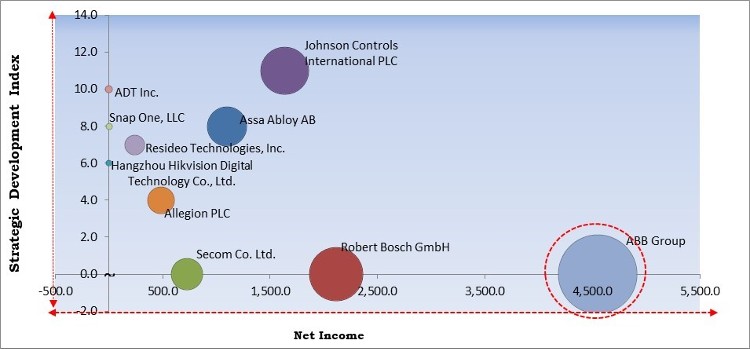
The major strategies followed by the market participants are Acquisitions. Based on the Analysis presented in the Cardinal matrix; ABB Group are the forerunners in the Home Security Systems Market. Companies such as Johnson Controls International PLC and Assa Abloy AB are some of the key innovators in Home Security Systems Market.
The market research report covers the analysis of key stake holders of the market. Key companies profiled in the report include Johnson Controls International PLC, Robert Bosch GmbH, ABB Group, Resideo Technologies, Inc., ADT, Inc., Assa Abloy AB, Allegion PLC, Snap One, LLC, Secom Co. Ltd., Hangzhou Hikvision Digital Technology Co., Ltd.
By Component
By Home Type
By Security Type
By Geography
The home security systems market size is projected to reach USD 96.5 billion by 2028.
The Internet of Things (IOT) and Wireless Technologies are Gaining in Popularity are driving the market in coming years, however, Costs of Installation, Maintenance, and Operation are high limited the growth of the market.
Molson Coors Beverage Company, The Boston Beer Company, Inc., The Pabst Brewing Company (Blue Ribbon Intermediate Holdings, LLC), Two Chicks Drinks, LLC, Blue Point Brewing Company (Anheuser-Busch InBev SA/NV), Loverboy, Inc., Bold Rock Hard Cider (Craft Revolution LLC), Crook & Marker LLC, Nude Beverages, and Cisco Brewers, Inc.
The expected CAGR of the home security systems market is 9.1% from 2022 to 2028.
The Condominiums/ Apartments market is leading the Global Home Security Systems Market by Home Type in 2021, thereby, achieving a market value of $59.7 Billion by 2028.
The North America market dominated the Global Home Security Systems Market by Region in 2021, and would continue to be a dominant market till 2028; thereby, achieving a market value of $34.6 billion by 2028.
Our team of dedicated experts can provide you with attractive expansion opportunities for your business.
